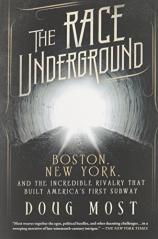The Race Underground: Boston, New York, and the Incredible Rivalry That Built America's First Subway
Review
The Race Underground: Boston, New York, and the Incredible Rivalry That Built America's First Subway
Like most Bostonians, I have a love/hate relationship with our subway system, known around here as the T. Sure, its color-coded train lines and relatively straightforward layout make it easy to navigate, and its Green Line trains (relics of the old streetcar days) are so cute. But the T's aging infrastructure is prone to massive malfunctions, it bypasses whole swathes of the city (primarily those occupied by minorities), and it stops running just after midnight. I've spent my fair share of time enjoying subway rides in Boston, as well as cursing its inadequacies.
One nice thing about riding the subway, though, is that it provides ample time for reading. I'm going to start suggesting that all my fellow subway commuters pick up a copy of Doug Most's THE RACE UNDERGROUND. It will help readers appreciate the subway, or at least understand it a little better. What's more, it provides insight into rivalries between New York and Boston that go way beyond the Red Sox and Yankees.
"All in all, THE RACE UNDERGROUND is a thoroughly entertaining story of how cities develop --- and why they sometimes fail to live up to their own best interests."
Most's story begins with an overview of the need for mass transit during the rapid growth of 19th-century cities and a survey of the (even more imperfect) mass transit options that preceded the subways of New York and Boston. These included buses that literally ran each other over in their quest for the next customer and streetcar lines owned by competing companies, resulting in a disorganized, inconsistent "system" of surface trains running higgledy-piggledy all over town.
In large part, the story Most tells is one of the men responsible for developing a better alternative. In particular, he focuses on the Whitney brothers, both originally from Massachusetts. William, who on paper is the more successful brother, moved to New York, socialized with the Vanderbilts, and held a cabinet position before turning his attention (and his substantial fortune) to railways on the street and below the surface. Henry, on the other hand, stayed near his parents' home in Brookline, Massachusetts, just outside Boston, where he quietly started buying up property along a corridor that soon became a major thoroughfare for carriages and streetcars alike. Most also tells the story of Frank Sprague, a former apprentice to Thomas Edison, who set off on his own when he realized that his mentor did not (to put it mildly) share his interest in applying electrical power to motors that could result in cleaner, safer trains. And he relates the story of Alfred Beach, who, years before there was an official subway in either city, built a secret subway under Manhattan, a block-long tunnel whose train was propelled through a pneumatic tube.
Beach's story of failure illustrates the kinds of obstacles faced by those who hoped to bring underground travel to America's cities: financial pressures, political interests and public skepticism. There were also plenty of other obstacles that faced the subways even after the blizzard of 1888 downed thousands of power lines, stranded thousands of commuters, and convinced many that underground commuting was a necessity. These included staggering costs, dangerous working conditions, and the potential for massive accidents.
All in all, THE RACE UNDERGROUND is a thoroughly entertaining story of how cities develop --- and why they sometimes fail to live up to their own best interests. It would be interesting to read this story alongside Neil Bascomb's HIGHER, which traces the race for dominance of the New York City skyline just a few decades later. Both books reveal as much about human egos and the complexity of cities as they do about their specific topics. And yes, either one would make excellent reading the next time you find yourself on a crowded subway car.
Reviewed by Norah Piehl on March 7, 2014
The Race Underground: Boston, New York, and the Incredible Rivalry That Built America's First Subway
- Publication Date: February 10, 2015
- Genres: History, Nonfiction
- Paperback: 432 pages
- Publisher: St. Martin's Griffin
- ISBN-10: 1250061350
- ISBN-13: 9781250061355





